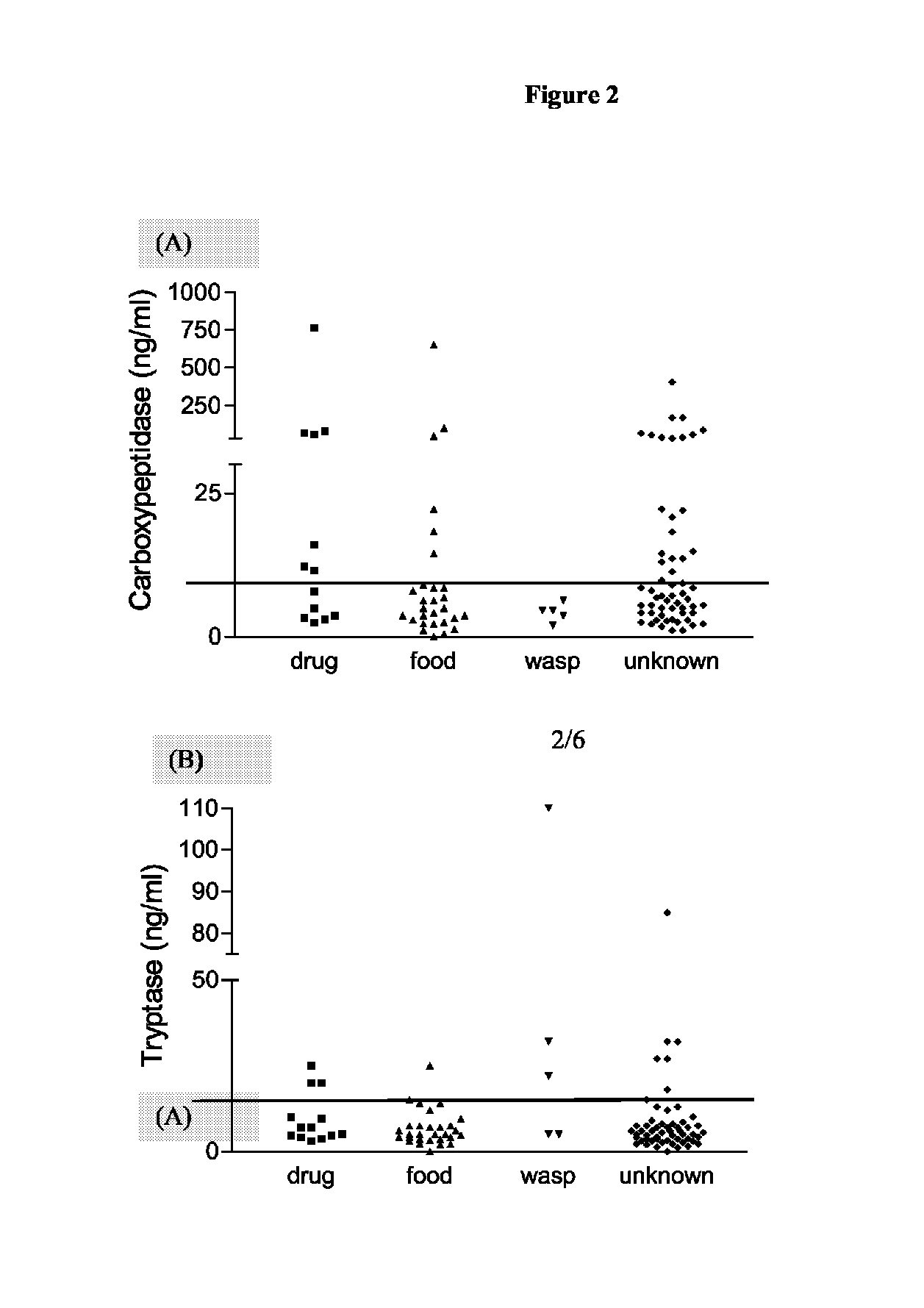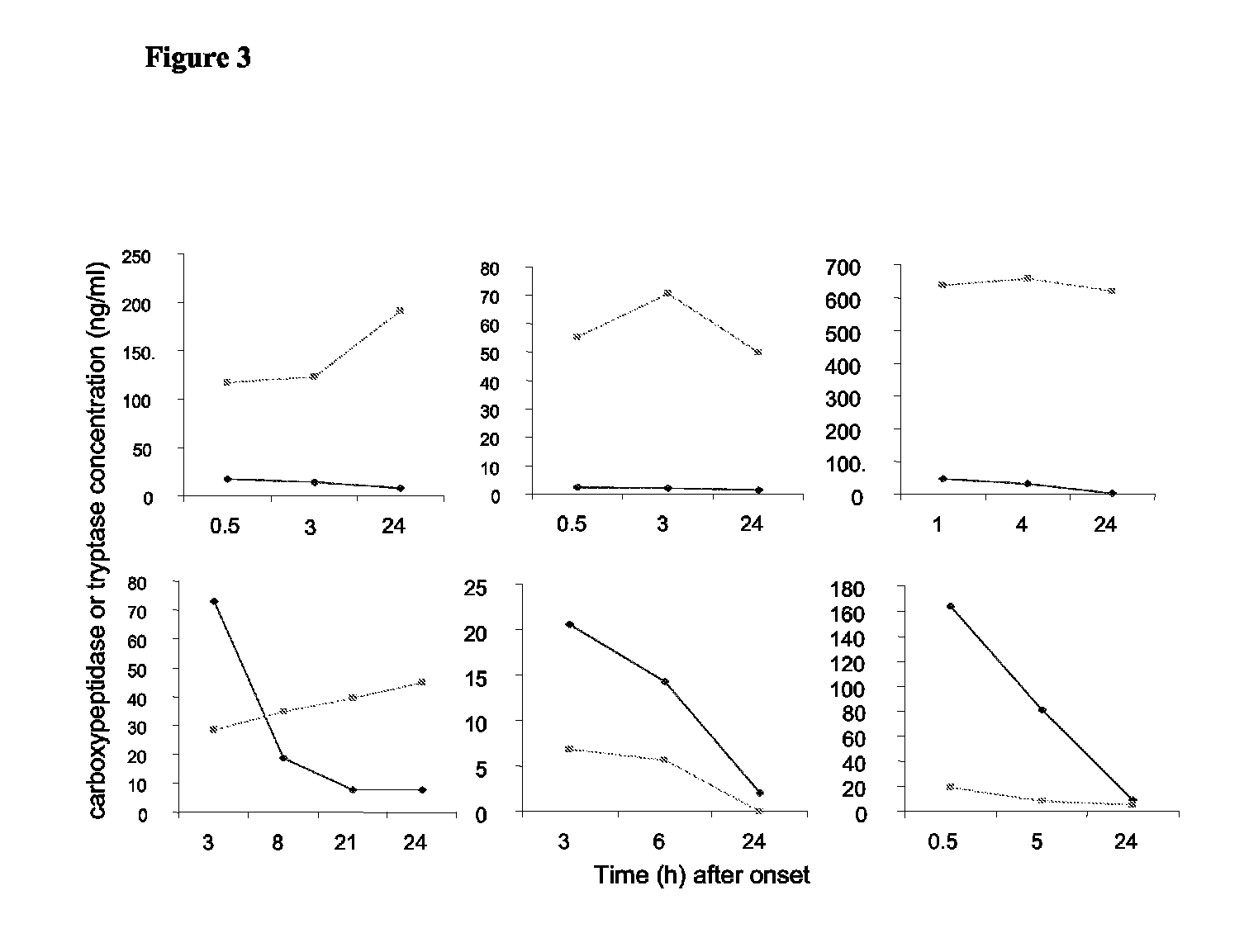Mast cell carboxypeptidase as a marker for anaphylaxis and mastocytosis
a technology of mastocytosis and mastocytosis, which is applied in the direction of material testing goods, biochemistry apparatus and processes, instruments, etc., can solve the problems of avoiding treatment, and affecting the safety of patients
- Summary
- Abstract
- Description
- Claims
- Application Information
AI Technical Summary
Benefits of technology
Problems solved by technology
Method used
Image
Examples
example 1
on and Characterisation of Antibodies Specific for Mast Cell Carboxypeptidase
Methods
[0024]Purification of Mast Cell Carboxypeptidase from Skin Extracts
[0025]Mast cell carboxypeptidase was purified from finely chopped extracts of human skin (obtained from macroscopically normal tissue at leg amputation) using a method adapted from that of Goldstein et al. (1989, ibid). Tissue extracts in a high salt buffer (2 M NaCl, 10 mM MES, pH 6.5) were applied to an affinity resin prepared by coupling potato tuber carboxypeptidase inhibitor (PCI) to cyanogen bromide activated agarose (Sigma, Poole, Dorset). After washing the column, carboxypeptidase was eluted with unconjugated PCI and dialysed to remove the inhibitor. The purity of the enzyme preparation was assessed by SDS-PAGE and silver staining (Pierce, Rockford, Ill., USA). Proteolytic activity was determined by monitoring the cleavage of 0.5 M hippuryl-Phe-Arg (Sigma) at 260 nm.
Cloning and Preparation of Recombinant Carboxypeptidase
[0026]...
example 2
Carboxypeptidase as Marker for Anaphylaxis and Mastocytosis
Methods
Subjects
[0035]Serum samples from 183 separate cases of suspected anaphylaxis had been referred from hospitals throughout the UK (obtained through Dr Richard Pumphrey and Mr Colin Summers, Manchester). All samples had been collected within 8 h of the onset of the reaction. Serum samples were obtained from Dr Luis Escribano (Madrid) from patients with different categories of mastocytosis. Paediatric mastocytosis cases included those with urticaria pigmentosa (19 samples) and diffuse cutaneous mastocytosis (5). Adult cases comprised: pure cutaneous mastocytosis with only skin involvement (3), indolent systemic mastocytosis (31), systemic mastocytosis associated with recurrent anaphylaxis without skin lesions (6), well-differentiated systemic mastocytosis (4), aggressive systemic mastocytosis (7), mast cell leukemia (1), and systemic mastocytosis associated with haematological non-mast-cell disease (7). As control groups,...
example 3
of Mast cell Carboxpeptidase in Saliva from Individuals Following a Food-Induced Allergic Reaction
Methods
Subjects
[0044]Three subjects were recruited who had a history of an allergic reaction to kiwi fruit, and three who had not experienced allergic symptoms on eating kiwi fruit.
Food Challenge
[0045]Saliva was collected from subjects prior to kiwi fruit being placed into the mouth. After 15 mins the fruit was spat out, and the mouth rinsed. Saliva was collected at regular intervals thereafter.
Results
[0046]All of the allergic subjects experienced itching of the oral mucosa after the kiwi fruit was placed in the mouth, and in one case oedema was observed. Increased levels of carboxypeptidase were detected in the saliva of all allergic subjects from the first time point examined, and high levels were maintained for at least 60 min afterwards. Levels in control subjects were substantially lower than in the allergic subjects.
PUM
| Property | Measurement | Unit |
|---|---|---|
| molecular weight | aaaaa | aaaaa |
| time | aaaaa | aaaaa |
| time | aaaaa | aaaaa |
Abstract
Description
Claims
Application Information
 Login to View More
Login to View More - R&D
- Intellectual Property
- Life Sciences
- Materials
- Tech Scout
- Unparalleled Data Quality
- Higher Quality Content
- 60% Fewer Hallucinations
Browse by: Latest US Patents, China's latest patents, Technical Efficacy Thesaurus, Application Domain, Technology Topic, Popular Technical Reports.
© 2025 PatSnap. All rights reserved.Legal|Privacy policy|Modern Slavery Act Transparency Statement|Sitemap|About US| Contact US: help@patsnap.com



